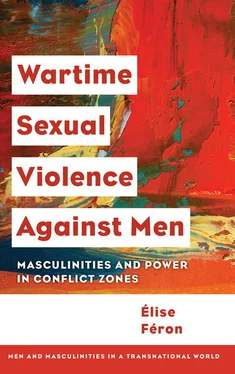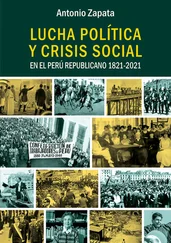Evidence from the fieldwork I have conducted in the Great Lakes region of Africa, but also to a lesser extent in Northern Ireland, is also quite compelling, and shows that in all these cases this type of violence has been frequent during conflict times, though silenced and overlooked by political authorities, survivors and relatives, as well as by non-governmental organizations. We will further explore these cases in the following chapters, but a few short examples will give a first overview of the phenomenon. At the Panzi hospital in Bukavu (South Kivu), for instance, the chief doctor I spoke with in 2012 reported two cases that had been treated the week before: the first was that of a driver who had been stopped on his way to Bukavu by an armed group, forced to rape all the people, male and female, who were in his van, and who then was himself raped by the members of the armed group (Panzi Hospital 2012, interview); [4] The doctor mentioned that none of the other male victims had reported to the hospital, which is a good indication of the very low level of reporting of such acts.
the second was that of a young man who had been forced to help an armed group by carrying around goods that they had stolen from various houses (including the young man’s) and had been subsequently gang raped by the members of the group. In both of these cases, there is a deliberate wish to instill terror, and to inflict pain and public humiliation (enforced rape and then gang rape in the first case, robbery and gang rape in the second). These cases are far from being isolated. Over the years, I have heard numerous similar stories, though the setting and identity of perpetrators obviously vary. According to a person working for the International Rescue Committee in the Great Lakes region of Africa (2012, interview), sexual violence against men, and more specifically male-on-male rape, has become just another strategy of war of armed groups active in the region, the ultimate aim being to force local populations into submission. Whether or not it is a pre-determined strategy, sexual violence is successful in instilling terror among civilian populations, without putting the perpetrators at risk since victims are almost never reporting it. According to the survivors’ and witnesses’ stories I have collected, when this violence is perpetrated during raids on villages, men are often forced to rape their own family members (forced incest). This of course entails humiliation and trauma for both the rapist and his victim(s), and family relations can never be fully mended. But in many instances sexual violence seems to also happen during detention periods, or shortly after men and boys have been abducted by armed groups—a trend that also characterizes sexual violence against women and girls.
Survivors’ experiences vary greatly, as do practices of sexual violence. Testimonies collected amongst refugees and internally displaced persons in Uganda by the Refugee Law Project (2013b, 18) offer a daunting overview:
- Oral rape, as well as rape using objects (e.g. screwdrivers, bottles);
- Having ropes tied to the genitalia and being pulled around by this rope;
- Having electric wires attached to the genitalia, through which electric shocks are administered;
- Linking two men using ropes tied to their genitalia and making them walk in opposite directions;
- Being made to dig holes in the ground, or in trees, and then to rub themselves in that hole to the point of ejaculation;
- Being forced to have vaginal sex with women of the same ethnic identity who are also being detained;
- Being forced to have anal or oral sex with fellow detainees, or with brothers or fathers;
- Being forced into sexual acts with your own spouse, while being watched by children, parents, etc.;
- Being used as a mattress while soldiers rape their family members on top of them;
- Being held for lengthy periods of time as sexual slaves;
- Forced circumcision, castration and other forms of genital mutilation.
In other settings, cases of forced bestiality, of acid poured on the genitals, of cigarette burns on the genitals, etc., have also been recorded. It is worth underscoring the fact that if sexual violence against men sometimes occurs during raids on villages or in a seemingly “random” manner, many of these cases take place in the specific setting of detention, where sexual torture is used in order to extract confessions, crush political dissidence or rebellion and/or for anti-terrorist purposes. In several cases, sexual torture seems to have been used by state security forces in an almost routine fashion. For instance, 21% of Sri Lankan men who were seen at a London torture treatment center reported sexual abuse while in detention (Stemple 2009), and in El Salvador, a survey of political prisoners at La Esperanza men’s prison revealed that 76% had suffered sexual abuse perpetrated by prison guards or interrogators during their incarceration (Leiby 2012, 341), with a predominance of cases of forced nudity, genital beatings, electric torture and rape or threats of rape.
A comparison of statistics available on sexual violence against men in detention settings suggests that the most frequent types of sexual violence perpetrated are beatings of the genitals, electrical torture in the genital area, introduction of foreign bodies in the rectal area, as well as sexual humiliation such as forced nudity. In Abu Ghraib, for instance, male prisoners were forced to remain naked for days in a row and were photographed while being naked. Further, sexual torture at Abu Ghraib and Guantánamo seems to have been specifically tailored to include what was assumed to be the most humiliating for Muslim detainees: “A Briton released from Guantánamo alleged that, as in Abu Ghraib, sexual humiliation was identified by US officials as a way of breaking Muslim detainees. In Iraq it was the simulation of oral sex, forced masturbation and human pyramids, with people kept naked for long spells. In Guantánamo, according to one British detainee, naked prostitutes paraded before inmates to taunt them” (Dodd 2004; see also, for an analysis of these narratives, Puar 2004). In Syria, Amnesty International (2012, 11) has collected testimonies of former prisoners detained by Syrian official security forces who had been “hit in the genital region with truncheons, (…) forced to watch as a male detainee [was being] raped (…), forced to have a glass bottle with a broken top inserted into his anus, (…) raped with a metal skewer”, among other abuses. Similar techniques of torture had been observed in the case of Sri Lanka (Peel et al. 2000, 2069).
1.3. PATTERNS OF WARTIME SEXUAL VIOLENCE AGAINST MEN
Is it possible to make sense of all these instances of violence? Quite obviously, patterns of wartime sexual violence against both men and women are tightly connected to the larger context. In particular, the conflict type (guerrilla war, civil war, genocide, interstate war, “war against terrorism”, etc.), but also the status of combatants (state or non-state), the terrain, the type and number of weapons available, among other factors, all seem to impact on patterns of sexual violence. This means that similar trends in occurrence and type of wartime sexual violence can be observed in very different settings, but also that similar types of conflicts can generate quite divergent patterns of sexual violence. Military strategy and control (or lack thereof) might, for instance, have a strong influence on the spread of sexual violence, as explained by Myrttinen (2014): “Sexual violence (…) is not something that happens in a vacuum and the driving factors are not the same in all conflicts. Whereas, for example, in the concentration camps of the Bosnian war sexual violence was used systematically against women and men, in other contexts, such as in the Democratic Republic of Congo, it may be more due to a loss of military control and individual frustration rather than a planned strategy”.
Читать дальше












